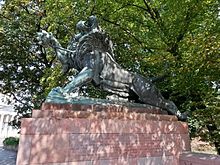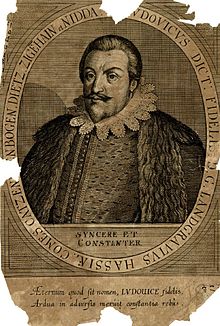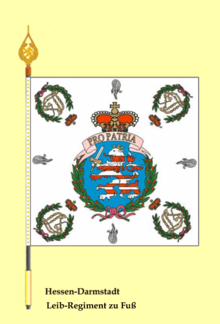Life Guard Infantry Regiment (1st Grand Ducal Hessian) No. 115
The Leibgarde Infantry Regiment (1st Grand Ducal Hessian) No. 115 was an association of the Grand Ducal Hessian Armed Forces, which had been integrated into the Prussian Army as a contingent since the military convention with Prussia of 1867 and last there was the Grand Ducal Hessian (25th) Division formed.
Foundation day
Established by Landgrave Ludwig V on the Foundation Day of March 11, 1621, it was the oldest active regiment in Germany. It was always stationed in Darmstadt with a crowd.
Regiment chief / regiment owner
- 1691 to 1738: Ludwig Balthasar Freiherr von Schrautenbach
- 1738 to 1778: The Hereditary Prince
Thereafter, the sovereign was always in the possession of the head office.
Submission in 1914
-
- Grand Ducal Hessian (25th) Division in Darmstadt
- 49th Infantry Brigade (1st Grand Ducal Hessian) in Darmstadt
List and history
Set up in 1621 as a normal infantry regiment, in 1806, after the Landgraviate of Hesse-Darmstadt had been elevated to a Grand Duchy , he was given the title of "Life Guard" regiment. Most recently it was called "Leibgarde Infantry Regiment (1st Grand Ducal Hessian) No. 115". The regiment owner was always the ruling Landgrave or Grand Duke .
- March 11, 1621: by order of Landgrave Ludwig V , a company of infantry was set up as "Company Dressler".
- 1630: With the “Company Dressler” as a tribe, the “Regiment von Leyen” was formed, the previous “Company Dressler” became the “Princely Body Company” within the regiment.
- 1632: The "Regiment von Leyen" was dissolved, the "Princely Body Company" remained as an independent association.
- 1646: With another five recruited companies, the "Princely Body Company" was increased to the "Body Regiment on Foot".
- 1647: The companies recruited the year before were dismissed, the previous regiment consisted only of the "Leib-Company".
- 1672: The body company was increased to 200 men and henceforth called "Life Guard on Foot".
- 1677: Two more companies were set up and the "Life Guard Battalion" was formed.
- 1687: The regiment fought under Prince Georg von Hessen on behalf of the Republic of Venice , which was allied with the Emperor and the Poles against the Turks , in order to support them in association with other German troops in the reconquest of the Peloponnese .
- February 1690: The regiment returned home because of the Palatine War of Succession with France that had broken out in the meantime. The personnel losses through fighting and illness were so blatant that in May 1689 the number was only 191 men. Ludwig Balthasar von Schrautenbach-Weitolshausen now took over the regimental command as a lieutenant colonel . In order to complete the so strongly melted regiment, it was merged with the previous bodyguard in 1691 and from then on bore the name "von Schrautenbach Regiment".
- 1691: After the number of staff had fluctuated several times in the past few years, the association was increased to a regiment again, without, however, remaining constant in the strength of the presence.
- April 1, 1697: Three companies were given up for the formation of the Ober-Rheinischer Kreis-Regiment (the later Prince Carl Regiment ).
- September 1, 1745: In the regiment the "1. Grenadier Leib-Komp. "
- March 1768: Creation of a 2nd Grenadier Company. The regiment was now called "Leib-Regiment zu Fuß" and consisted of two battalions of one grenadier and four musketeer companies.
- 1790: Surrender of the two grenadier companies to form the 1st Leib grenadier battalion
- June 1, 1803: Under French influence, a reclassification took place. The infantry was divided into three field brigades and three reserve brigades. Field Brigade 1 was the body brigade and consisted of the "Leib-Regiment zu Fuß" (body regiment on foot) with two battalions of four companies and the fusilier battalion.
- August 18, 1806: The “Leib-Brigade” was renamed “Leib-Garde-Brigade”, the “Leib-Regiment” into “Leib-Garde-Regiment”, the fusilier battalion into “Guard-Fusilier-Bataillon”.
- March 1, 1812: The Guard Fusilier Battalion was released from the Brigade Association. The brigade structure was dissolved and the Leib-Garde Regiment consisted of two battalions. The Guard Fusilier Battalion was used with the I. Leib Fusilier Battalion of the Leib Regiment to set up the provisional light infantry regiment .
- 1812: In the campaign to Russia , the "Leib-Garde-Regiment" was almost wiped out.
- 1813: The "Leib-Garde-Regiment" was reorganized with two battalions of four companies each.
- July 1, 1820: reorganization of the armed forces. The regiment received two companies from the disbanded "Prince Emil Regiment".
- April 11, 1830: The regiment was named “1. Infantry Regiment (Leib-Garde-Regiment) ”and led this until 1872.
- April 7, 1867: Military convention with Prussia.
- July 1, 1866: The rifle company left the regimental association.
- June 13, 1871: New military convention with Prussia. The Hessian contingent remained as a closed division in the association of the Prussian Army. The addition "Grand Ducal" was introduced.
- January 1, 1872: The structure of the association was reformed according to the Prussian model. The former "Guard Jäger Battalion" was initially attached to the regiment as the Guard Fusilier Battalion, but continued to carry the Jägerhorn in the battalion flag. Personnel had to be handed in to form the fusilier battalion of the infantry body regiment . The Grand Duke. Hessian troops appeared for the first time in the ranking for 1872. The regiment was named “1. Grand Ducal Hessian Infantry (Life Guard) Regiment No. 115 ”and led this until 1906
- April 1, 1881: 11th Company surrendered to Infantry Regiment No. 116
- April 1, 1887: Transfer of the 8th Company to Infantry Regiment No. 138
- January 4, 1889: The Guard Fusilier Battalion was in III. Battalion renamed
- August 2, 1893: formation of an IV (half) battalion.
- April 1, 1897: Delivery of the 4th Battalion to the formation of Infantry Regiment No. 168 .
- November 28, 1906: For the last time the name changes to: "Leibgarde-Infanterie-Regiment (1st Grand Ducal Hessian) No. 115"
Uniformity
Blue tunic according to the Prussian pattern with red badge color. On the collar and on the Brandenburg lapels , lace made of white wool (for officers made of silver) was worn. A special feature of the officers was that the lower sleeve strands were not buttoned through, and instead of the lap color (here red) the background of the buttonholes was lined with white as usual. A crowned “L” was worn on the shoulder pieces until 1897, after which an “EL” was worn. The 1st Company was called "Leibkompanie" and had an "L" on the buttons of the epaulettes instead of the usual company number. The new model of the Pickelhaube from 1887 had all fittings in white metal , on the front the armored and crowned Hessian lion surrounded by branches, in the background a bandeau with the dates “1621” and “1897”, with the guard star on top. This was done in email and exalted by the officers. The belt lock only had a 5-bowed crown in white metal. The officer's sash was made of silver and had three red drawstrings. The armband in the same color, the lock was provided with a crowned "EL". The armpits of the officers were made of silver with a red finish. In 1913, the field-gray uniform was worn for the first time during maneuvers and exercises.
In 1908 and 1909 the Leibcompanie won the Kaiserpreis for best shooting performance within the infantry of the XVIII. Army Corps and was allowed to wear a corresponding badge on the sleeve of his skirt.
Battle calendar
Thirty Years' War
- 1636: Second siege of Magdeburg
Dutch War
- 1677/78: Campaigns with the Imperial Army on the Rhine and Saar against France
War of the Palatinate Succession
- 1689/96: against France on the Rhine and in the Netherlands
- 1689: capture of Mainz
- 1695: Storming of Namur
War of the Spanish Succession
- 1702 to 1713: War against France on the Middle and Upper Rhine
- 1702: Battle of Friedlingen, Landau fortress is taken
- 1703: Defense of Landau, Battle of the Speyerbach
- 1704: Landau is captured
War of the Polish Succession
- 1734/35: Fights against France on the Upper and Middle Rhine
War of the Austrian Succession
- 1747 to 1749: fighting against France in the Netherlands
American War of Independence
- 1776–1783: Foreign assignment in North America: Battle near Flatbush , near New York (Incleberg), near White Plains , Woodbridge, on the Brandywine River, near French Creek, storm on Fort Reedbank, in Canada, battle near Stillwater, surrender of Saratoga, Siege of Charlestown
Coalition wars
- 1792/93: Fights on the Main and Middle Rhine against France
- 1793: Capture of Mainz , battles near Buchsweiler , near Lembach , and near Weissenburg , battle near Kaiserslautern
- 1794: Defense of Mainz
- 1795: Battles near Kreuznach and Planig
- 1796: Battle of Altenkirchen , Battle of Limburg , battles near Runkel and Oberlahnstein , Battle of Neuwied , battles near Bendorf , near Montabaur , battles near Mainz and Wiesbaden
- 1798/99: with the Imperial Observation Army on the Lech
- 1806/07: On the French side against Prussia:
- 1806: Battle of Jena
- 1807: Battles near Graudenz , siege of Graudenz, battle near Neudorf, siege of Stralsund
- 1809: Fighting against Austria on the French side:
- Battle near Efferding, near Ebelsberg, battle near Aspern , battle near Wagram , battle near Znaim .
Campaign to Russia
- 1812 Battle of Smolensk , Battle of Borodino , Battle of the Moskva , Battle of Krasnoye , Battle of the Berezina , battles near Wilenka, Slavotka and Wilna
- 1813 Battle near Dirschau. Fight against the allies in Saxony and Silesia . Battle of Großgörschen , Battle of Bautzen , Battle of the Nations near Leipzig , Defense of Torgau .
Rule of the hundred days
- 1815: Battles near Rheinzabern , Strasbourg , siege of Neubreisach and the fortress of Hüningen
German Revolution 1848/1849
- 1848: Street fighting in Frankfurt am Main
- 1849: Fights against revolutionaries in the Rhine Palatinate and in the Grand Duchy of Baden . Capture of Worms , battles near Hemsbach, near Weinheim , near Käferthal , near Greater Saxony, near Sinsheim , near Gernsbach and near Oos .
German war
- 1866: Battles against Prussia: Skirmishes near Frohnhofen / Laufach , Weiler, near Aschaffenburg , Stockstadt , Mainflingen and Gerchsheim.
Franco-German War
- 1870/71: Battle of Vionville , Battle of Gravelotte , battles near Noisseville, battles near Montbarrois and Orléans , battles near Meung, Beaugency, Montlivault and Chambord, near Bienne, on the Braye Bach, near La Motte-Beuvron, near Dhuizon, enclosure of Metz , Battle of Le Mans . The Pioneer Company (later the 9th Company in Infantry Regiment No. 117) was involved in a battle near Epuisan.
Boxer Rebellion
- 1900: Participation of volunteers in the East Asian Expeditionary Corps .
First World War
The regiment consisted of three battalions with four companies each, plus a machine gun company per battalion from 1913 onwards. After the mobilization order was received on August 1, 1914 , the regiment was ready to march on the fifth day of mobilization with a strength of 83 officers, 3305 NCOs and men and 240 horses. In May 1915 the 13th and 14th companies were set up, and the 2nd and 3rd MG companies were set up on October 20, 1916.
1914
- Battle of Neufchâteau , battles near Moissin and Anloy, battles on the Meuse and Marne , battles near Sermaize, Maurupt-et-le-Montoy, near Reims , near Roye, Gruny Fresnoy, Goyenmurt, Gorullers.
1915
- Fights at Neuve-Chapelle, Roue, Beuvraignes.
1916
- Battle of Verdun - Fights in the Caures Forest, near Beaumont, on the Pepper Ridge, in the Chauffour Forest, Caillette Forest, Albain Forest and at Fort Douaumont .
- Fight on the Aisne,
- Battle of the Somme ,
- Fight between Meuse and Moselle .
1917
- Fight on the Somme
- Fight in the Siegfriedstellung
- Battle of Flanders .
1918
- Great battle in France ,
- Breakthrough between Houzéoucourt and Vermaud
- Fight in the summer area near Bourhavesnes, in the Marrimes forest and near Maurepas
- Fourth Battle of Flanders
- Defensive battle between Somme, Oise and Scarpe
- Fight in front of the Siegfried and in the Hermann position
- Retreat fighting in the Antwerp-Maas position .
losses

The recorded casualties in the First World War were:
- 139 officers
- 327 NCOs
- 2518 teams
In addition, there are a not inconsiderable number of missing persons - most of whom are to be counted among the dead, as well as those who died after the war as a result of the war.
Replacement troop units
- "1. Replacement Battalion InfRgt 115 “set up in Darmstadt. Two of these companies joined the
Brigade Replacement Battalion No. 49, the 1st and 3rd Company (as 1st and 3rd Company) to Reserve Infantry Regiment No. 221 and the 5th Company (as 5th Company) to Infantry Regiment No. 625.
- "2. Replacement Battalion InfRgt 115 “set up in Darmstadt. Disbanded June 30, 1917.
Whereabouts
After the Compiègne armistice , the remnants of the regiment marched back home. From December 20, 1918, the 1st and 2nd Battalion was in Michelstadt , the Guard Fusilier Battalion in Darmstadt. Then all units in Erbach (Odenwald) were combined and demobilized there . The regiment was finally disbanded on April 23, 1919.
In January 1919, a volunteer battalion with MG and MW companies was set up from parts of the demobilized regiment , which was deployed in the Hesse Freikorps in the following months. With the formation of the Provisional Reichswehr , it was integrated into the Reichswehr Rifle Regiment 35 as the 1st Battalion from June 1919.
tradition
The tradition continued in the Reichswehr with the 1st Company of the 15th Infantry Regiment in Giessen .
Commanders
| Rank | Surname | date |
|---|---|---|
| Colonel | Eduard von Grolman | February 3, 1862 to December 27, 1866 |
| Colonel | Adolf Kehrer | January 24th to July 9th, 1867 |
| Lieutenant colonel | Karl Wilhelm Keim | July 10, 1867 to May 31, 1868 |
| Lieutenant colonel | Moritz von Frankenberg and Ludwigsdorf | June 1 to July 2, 1868 (in charge of the tour) |
| Colonel | Moritz von Frankenberg and Ludwigsdorf | July 3, 1868 to November 6, 1869 |
| Lieutenant colonel | August Coulmann | November 6, 1869 to October 30, 1871 |
| major | Carl Ludwig Anschütz | October 31 to December 31, 1871 (in charge of the tour) |
| Colonel | Dietrich von Grawert | January 1, 1872 to October 14, 1874 |
| Colonel | August von Seebeck | July 20, 1882 to December 3, 1886 |
| Lieutenant colonel | Hermann von Chappuis | December 4, 1886 to April 15, 1887 (in charge of the tour) |
| Colonel | Hermann von Chappuis | April 16, 1887 to February 14, 1890 |
| Lieutenant colonel | Heinrich von und zu Egloffstein | January 27, 1893 to February 13, 1894 (in charge of the tour) |
| Colonel | Heinrich von und zu Egloffstein | February 14 to June 11, 1894 |
| Colonel | Alexander Rüdt von Collenberg | July 22, 1900 to October 27, 1902 |
| Lieutenant colonel | Alfred von Besser | October 28, 1902 to January 26, 1903 (in charge of the tour) |
| Colonel | Alfred von Besser | January 27, 1903 to March 21, 1907 |
| Colonel | Oskar von Hutier | March 22, 1907 to March 21, 1910 |
| Colonel | Otto von Etzel | March 22, 1910 to February 19, 1912 |
| Colonel | Wolf von Helldorff | February 20, 1912 to August 1, 1914 |
| Lieutenant colonel | Ludolf von Oven | 2nd to 21st August 1914 |
| Colonel | Maximilian of Prussia | September 19, 1914 to March 22, 1916 |
| major | Ernst Nigmann | March 23 to May 30, 1916 |
| Colonel | Maximilian of Prussia | May 31 to December 20, 1916 |
| Lieutenant colonel | Leopold von Kleist | December 21, 1916 to April 27, 1917 |
| major | Karl von Rettberg | April 28 to November 18, 1917 |
| Lieutenant colonel | Eduard von Westhoven | November 19, 1917 to May 12, 1918 |
| major | Karl von Büdingen | May 13 to October 1918 |
| Colonel | Heinrich von Westernhagen | October 1918 to January 1919 |
| major | Karl von Rettberg | January 1919 |
literature
- Carl Christian Röder von Diersburg, Fritz Beck: History of the 1st Grand Ducal Hessian Infantry (Leibgarde-) Regiment No. 115, 1621-1899. Berlin 1899. Digitized in the Google book search
- Alex-Victor von Frankenberg and Ludwigsdorff: The Life Guard Infantry Regiment (1st Grand Ducal Hessian) No. 115 in the World War 1914–1918. Belser Verlag. Stuttgart 1921, DNB 579403076 .
- Three hundred year life guard regiment. Sheets in memory of the glorious past of the Life Guard Infantry Regiment (1. Großh. Hess.), No. 115. Kichler, Darmstadt 1929, DNB 361869657 .
Web links
- Image of the regiment at the outbreak of war on the way to the train station
- List of casualties officers and NCOs 1914/18
Individual evidence
- ↑ Also known as the holder's position
- ^ Jürgen Kraus: Handbook of the units and troops of the German army 1914-1918. Part VI: Infantry. Volume 1: Infantry Regiments. Verlag Militaria, Vienna 2007, ISBN 978-3-902526-14-4 , p. 195.








